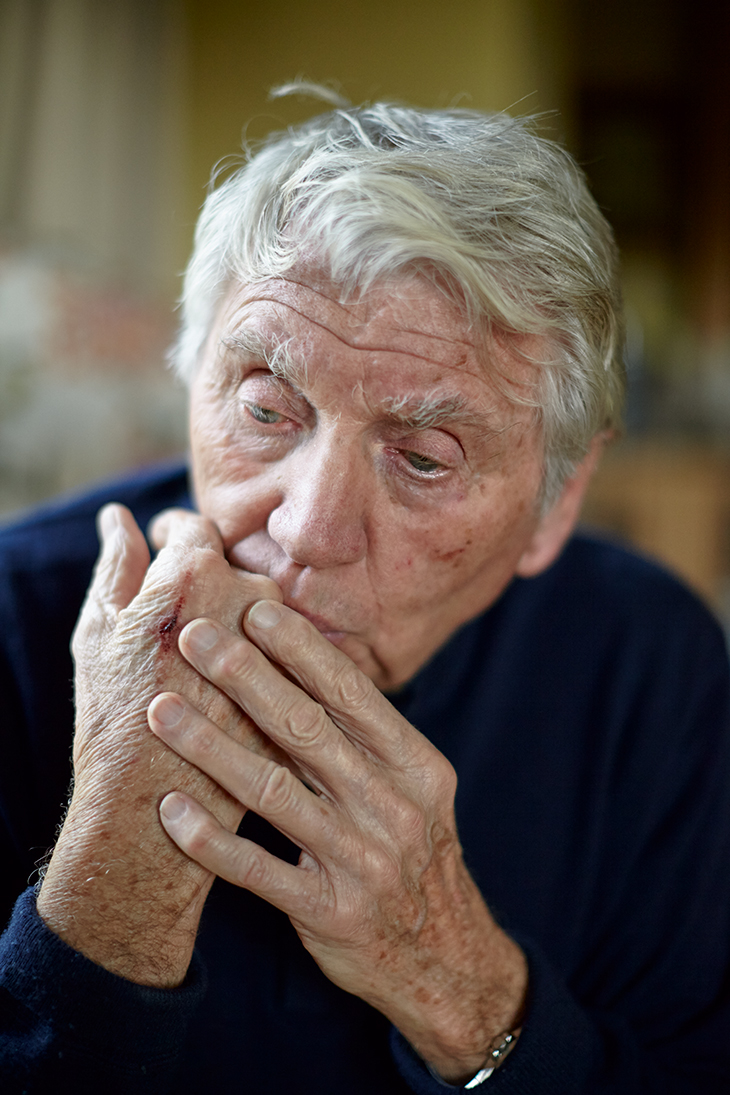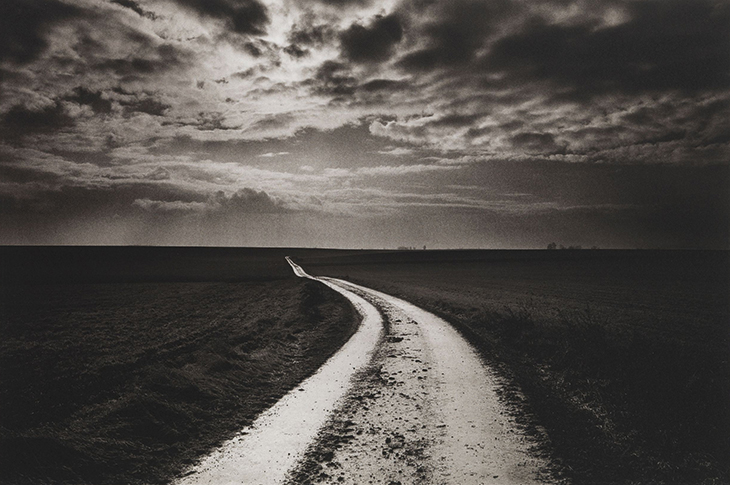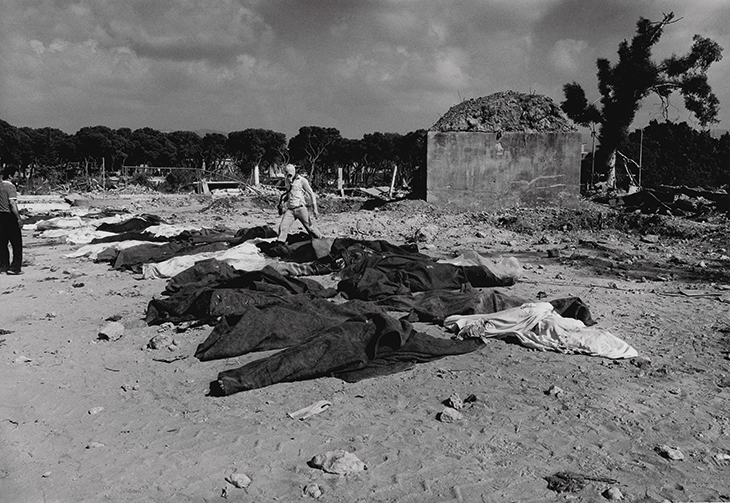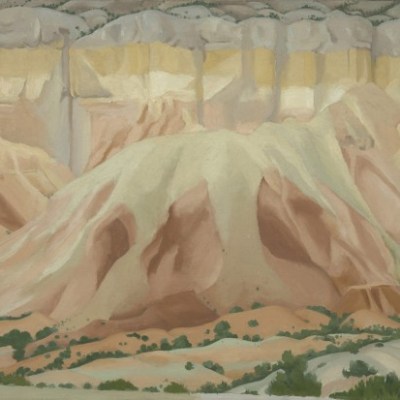On top of a hill a few miles from Don McCullin’s house in Somerset is a dew pond, a perfectly circular artificial pond for watering livestock. Nobody knows how long it has been there; some dew ponds date back to prehistoric times, and it’s tempting to think that this one served the Bronze Age hill-fort that overlooks the site. McCullin is obsessed with the pond. For more than 30 years, whenever he has had the time, he has walked up the hill and stood there with his camera waiting for the right moment to take a photograph. Often, the moment never comes: he can spend hours there, just looking. ‘It’s as if it has a hold over me,’ he tells me when I visit him at home in early January. ‘I can’t leave it alone, I photograph it all the time. And yet I think I’ve done my best picture the first time I ever did it. I can’t tell you how.’
That picture, taken in the 1980s, is one of more than 70 landscape and still-life photographs that McCullin has selected for an upcoming exhibition at Hauser & Wirth Somerset (25 January–4 May). They show a less familiar side of the world’s most renowned photojournalist, known above all for his images of war and poverty. The photographs are selected from throughout McCullin’s long career, which began in the 1950s and has taken him all over the world, from devastating conflicts to key moments in British post-war popular culture – but the majority of the photos on show have been taken within a few miles of his house. At 84, McCullin is still working, and the landscapes are now his driving passion.
To reach McCullin’s house from London you travel west, out through the city’s periphery of warehouses and office blocks; across Salisbury Plain, home to ancient ritual sites and modern-day military training grounds; and into the hills that border the Somerset Levels. It’s a journey McCullin first made at the age of five, when he was evacuated in 1940 from his home in Finsbury Park, north London. The photographer has spoken many times over the years about the way in which his impoverished and often violent childhood influenced his work, pushing him to gather images of human suffering. The two years he spent in Somerset, however, left him with an ‘idyllic’ memory that he kept with him over the years and which eventually, in the mid 1980s, drew him back.
Don McCullin photographed in Somerset in January 2020. Photo: Toby Glanville

The morning I arrive at McCullin’s old limestone farmhouse, where he lives with his wife Catherine Fairweather, he has been up since dawn, looking out at the valley beyond his front windows to see if the sky will change. For the past few days the light has been no good, all grey and overcast. What he needs is some brightness, the sun glowing from behind the clouds, to give him the ‘Wagnerian’ skies he likes to photograph under. McCullin’s landscapes take simple elements – trees overhanging water, a pond, a flooded field – and transform them, through his use of light and dark, into dramatic, clashing compositions on his characteristic monochrome prints. In theory, the subject matter couldn’t be further away from some of his most famous pictures – grieving women during the civil war in Cyprus, a shell-shocked US soldier in Vietnam, rough sleepers in east London, the war in Lebanon – but there is an affinity between the two sides of his work. Trees become jagged etchings across the clouds; Hadrian’s Wall, photographed in the snow, is a scar running through the countryside; a flooded field in Somerset looks like the Somme – and, indeed, prompted the Post Office to commission him to photograph the First World War battlefield, where he also shot The Road to the Somme, France. McCullin photographs the rural landscape only in winter, when the trees are ‘naked’.
The obvious assumption is that McCullin turned to landscape photography as an escape from the stresses and trauma of covering war. But as we sit down to talk, by a window in his living room, he tells me it wasn’t quite like that. ‘To be truthful, I did it because it’s there. When you live in this house, you can’t avoid what’s going on outside. Because the light is pouring in here and it’s as if I’m being invited to go out there and pick up on it.’ McCullin has never had trouble motivating himself to work – he talks of photography choosing him, rather than the other way round – but just recently, he says, he has found his mind beginning to drift. ‘In the last two months, I’ve noticed there’s something not right about my disposition,’ he says. ‘I feel there are forces now trying to take me away from what I’m best at. I’m still very creative in my thoughts, but my thoughts lately have been sidetracked. I’ve been avoiding the darkroom lately. And I said to my wife the other day, “Do you know something, I don’t think I’m going to go in the darkroom again.” She said “Oh, you can’t say that…”’
The darkroom that sits in a barn behind McCullin’s house is where as much of the photographer’s energy goes as in the field. A master printer, he tears up scores of prints he considers inferior, because ‘When I die I don’t want people to find prints that aren’t good enough.’ But recently, he says, he’s been finding excuses not to go in there. In part, he thinks, it’s because his body is starting to break down – he is strong for his age but becoming frail nonetheless: he suffers from arthritis, the darkroom chemicals are starting to make his chest wheeze – but it’s also an after-effect of the major retrospective he staged at Tate Britain last year.
The Road to the Somme, France (1999; printed in 2019), Don McCullin. Courtesy the artist and Hauser & Wirth; © Don McCullin

That exhibition presented a huge selection of images from McCullin’s career, from his days documenting 1950s working-class life in Finsbury Park – the first photograph he sold, of a Teddy boy gang in a derelict building, was one he took in his spare time with a camera he had bought while on national service – to most of the major wars of the late 20th century (many photographed for the Sunday Times, his main employer for years), to social reportage in the north of England. The critically acclaimed show attracted more than 180,000 visitors, and will move to Tate Liverpool this June, but it’s hard for that not to feel like a full stop on a career. ‘The Tate probably damaged me a bit, because it said “This is it.” You have all these people come, say nice things, and you think, what else can I say?’
One of the reasons McCullin remembers his childhood years in Somerset with such fondness is that soon after he left, his mother ‘shipped me out again’, this time to Manchester. There, he stayed with ‘a brutal family, who used to punch me around. I never had a bath in months up there, and they used to lock me out at night in the winter, because they wouldn’t have us in the house until 10 o’clock, when we’d sleep on the floor on a mattress.’ He has a lot of stories like this from his youth: the damp basement flat in which his family lived, which contributed to the early death of his asthmatic father; harsh schools with ‘sadistic’ teachers. He has said in the past that ‘I know the feeling of the people I photograph. It’s not a case of “There but for the grace of God go I”; it’s a case of “I’ve been there.”’
In the 1970s, burned out and haunted by a decade of photographing war, McCullin turned his attention to England, producing a series of photographs – of Bradford, of Liverpool, of County Durham, of London’s Whitechapel – that laid bare the deep divisions of class and wealth in his home country. In the past, he has described the poverty he photographed in England as a ‘social war’, and to him the war is ongoing. McCullin is sceptical that the optimistic pitch of Britain’s new government will bear fruit. ‘If [people] think for a second their lives are going to change overnight, it’s not. What they don’t understand is that what was once a great country which stole other people’s resources by colonising, [no longer has] that choice any more to steal from other countries.’
Liverpool, Slum Clearance (1970s; printed in 2017/18), Don McCullin. Courtesy the artist and Hauser & Wirth; © Don McCullin

Although people are absent from his landscape photographs, they also raise uncomfortable questions about our future. With a yellow filter on his camera to accentuate the contrasts, and careful choice of paper in the darkroom, the rural English landscape, which occupies such a sentimental place in the national imagination, becomes mysterious and threatening. It’s a reminder that this, too, is a land shaped by conflict and suffering, over hundreds or even thousands of years. His ominous skies and ever-present water – ponds, rivers, saturated fields, the flooded Somerset Levels – hint at the destructive power of our climate, too.
‘There is energy, the energy of history around this landscape here,’ McCullin tells me, as we look out of his living-room window, across the valley in front of his house. The remains of a Roman temple are visible in the distance. Not far from here is the probable site of the Battle of Edington, where King Alfred repelled an army of Vikings. The hills near his house turn up fossils, one of which sits on the window sill. Often, it’s these sorts of connections that draw McCullin to the places he photographs. ‘The thing about mythology is that it’s heavily overloaded; most stories over time have been packed with embellishment. But we need a little bit of daydreaming sometimes, don’t we?’
McCullin takes me through the house, to a storeroom where he keeps his life’s work. The room is packed from floor to ceiling with archive boxes of prints and negatives whose labels say things like ‘Cambodia’, ‘Beatles’ and ‘Not too bad’. There are 60,000 negatives and 10,000 prints in the room, he tells me. ‘I did a book once called Sleeping with Ghosts,’ McCullin says, ‘and it was basically meaning this house. Those negatives contain the most appalling things, some of which you saw at the Tate. But there are some even worse ones in here. I’ve been in this house 36 years, and I brought the haunted side to it with these negatives. I have all these pictures of men who died.’
After the Massacre of Sabra Camp in Beirut (1982; printed in 2013), Don McCullin. Tate, London. Courtesy Hamiltons Gallery, London; © Don McCullin

The pictures in this room are documents of historical events, but they are also history in their own right. McCullin’s photos helped create the visual language of suffering that pervades media culture in our own century, from humanitarian appeals to modern-day refugee crises. He has talked openly in the past about the guilt that comes with taking such photos – that you are ‘stealing’ people’s stories, that you are watching as they suffer or even die in front of you – and the manipulation involved in their selection and presentation to audiences. Yet there is something about his pictures that goes beyond their immediate context. You could see this in the Tate exhibition last year; even among the crowds of tourists, these are images that stop you in your tracks, forcing you to confront the people or places they show. They are things that neither glossy magazines during the heyday of print journalism nor the accolades showered on him by the British establishment can quite contain. (McCullin has been knighted and made a CBE.) It’s telling that in 1982 he was refused permission by the government to cover the Falklands War.
McCullin is reluctant to place himself in the company of artists, partly because he never wants to feel that he’s ‘arrived’ – ‘The moment that happens, I know I’m finished’ – but also because of the nature of his material. ‘There’s a shadow that comes over my life when I think […] that I’ve earned my reputation out of other people’s downfall. I’ve photographed dead people and I’ve photographed dying people, and people looking at me who are about to be murdered in alleyways. So I carry the guilt of survival, the shame of not being able to help dying people.’ Yet the artist’s name that comes up most frequently in discussion of his work is Goya. McCullin first saw Goya’s Black Paintings on a visit to the Prado in Madrid in the early 1980s and was shocked to find a painter who ‘saw what I saw. When I look at some of his drawings, people are looking up for salvation, just before they’re being shot. I’ve seen that with my own eyes.’ He is adamant, however, that he is only a ‘trespasser’ in the art world, and would rather be known simply as a photographer. ‘I’m not an artist, even though I compose my pictures as best I can. In a split second under fire, some people wouldn’t bother, but I’ve stood up in battles and put up the exposure meter first, because I’m not going to get killed for an underexposed negative. But the great thing about landscape is that you owe nothing to fear. It’s all yours, no one can say you’re doing the wrong thing morally, there’s not a human being that can come up and say “Why are you taking my picture?”’
Batcombe Vale (1992–93; printed in 2019), Don McCullin. Courtesy the artist and Hauser & Wirth; © Don McCullin

In terms of direct influences, McCullin names the early 20th-century photographer Alfred Stieglitz. His pictures were ‘mostly about beauty’, but McCullin says they taught him about ‘the dignity of photography’. Stieglitz was of German-Jewish origin, a fact that prompts McCullin to remark on how many of the photographers and picture editors he encountered early on in his career were from similar backgrounds; refugee intellectuals who brought European modernism with them to London. ‘They’re the people who gave me life, you could say.’
Our interview almost over, McCullin offers to drive me up to see the dew pond. On the way, he describes how he’s planting trees – poplars, chestnuts, walnuts and limes – in the valley beneath his house. ‘I feel obliged now, since trees are very important in my landscapes. I should contribute.’ After ten minutes or so, we arrive at the pond. ‘You probably think I’m mad bringing you up here,’ he says, ‘but I wanted to show you. It’s one of the simplest, most beautiful things you’ll ever see.’ In his photo, the pond is a silver disc, shining out beneath a lowering sky; today, it’s bright blue, a dot of stillness among the muddy winter fields.
McCullin is a striking person to spend time with, still consumed by photography, good-humoured and reflective about the craft and ethics of his profession – but the conflict that has shaped his life is never far from the surface. I tell him that this comes through even in his photographs of the countryside. ‘You may also consider that I’m poisoning it, by the way I present it,’ he says. ‘But you’ve got to love somewhere like this to be able to bring the best out of it.’
On the way back, McCullin spots a field he wants to come back and photograph later. ‘It’s slightly flooded but not saturated so that when the light’s hitting it it’s like a silver landscape, but it was no good with the sky that’s been going on here for the last five days.’ He hasn’t quite abandoned the darkroom yet, either. ‘I’ve cleared all the crap out of there and I’ve set the dishes up to go in there on Monday morning next week. So the spark is still there.’
‘Don McCullin: The Stillness of Life’ is at Hauser & Wirth, Somerset, until 4 May; ‘Don McCullin’ is at Tate Liverpool from 5 June–27 September.
From the February 2020 issue of Apollo. Preview and subscribe here.



